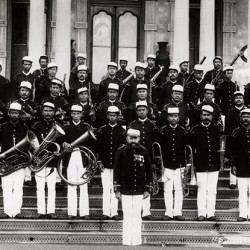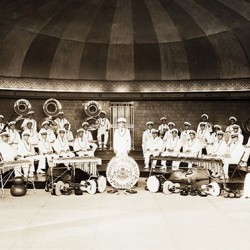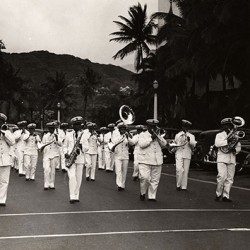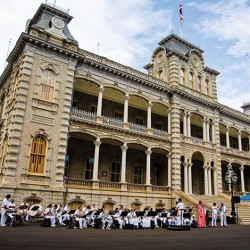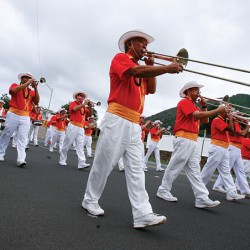Centuries of Song
Explore Hawai‘i’s rich musical legacy with the Royal Hawaiian Band—the only band in the United States with a royal legacy.
If you thought the Rolling Stones have been around a long time— think again.
The Royal Hawaiian Band, a 40-member ensemble of musicians that plays weekly around O‘ahu, has been in existence for over 175 years.
In 1836, the ruling monarch, King Kamehameha III, ordered the formation of a band that would play at the palace, lead marches to important gatherings and celebrate the sounds of Hawai‘i.
Today, the band meets Wednesday through Sunday, learning new arrangements and performing around 340 concerts and parades each year under the direction of Bandmaster Clarke Bright. They have traveled to neighbor islands, as well as Japan, Europe, Canada and the mainland. In the early 1980s, the band performed onstage at Carnegie Hall.
Each member will tell you that it’s an honor to join the only band in the United States with a royal legacy. Their goal is to promote and foster both historically accurate and contemporary music among young people, the citizens of Hawai‘i and visitors. The band is responsible for the preservation of Hawaiian music—in all its forms.
Former Miss Hawaii (2001) Denby Dung serves as a clarinetist. “The Royal Hawaiian Band has always performed music written and arranged by our ali‘i, and we continue that important tradition today, performing songs exactly the way they were written almost 200 years ago,” Dung says.
- ROYAL HAWAIIAN BAND, 1880S. PHOTOS: HONOLULU STAR-ADVERTISER
- THE BAND PLAYING FOR FUNERAL, 1939
- THE BAND IN FRONT OF ‘IOLANI PALACE
Indeed, one of Hawai‘i’s most beloved monarchs, Queen Lili‘uokalani, was also one of its most prolific songwriters. In total, she composed more than 150 songs. Perhaps most well-known is the tune “Aloha Oe.” A manuscript in the Queen’s handwriting says, “Composed at Maunawili 1878. Played by the Royal Hawaiian Band in San Francisco, August 1883, and became very popular.”
As history goes, she was imprisoned in ‘Iolani Palace when the monarchy was being overthrown. It was during this time that she wrote several songs, including “Paoakalani,” a song still played by the band with frequency.
“Her home was in a part of the island called Paoakalani,” Dung says. “When she was imprisoned, the Queen had no way of knowing what was happening outside the palace walls. One of her few privileges was receiving flowers from her properties around the city. One day, she recognized a species that grew at Paoakalani, her home in Waikiki. She was so inspired that she wrote ‘Paoakalani’ and dedicated it to the boy whose duty it was to bring her the flowers—Johnny Wilson, who later became Mayor of Honolulu. He would wrap the flowers in current newspapers, which is how the Queen would get information about what was happening outside the palace.”
Emalia Keohokalole and her three brothers—direct descendants of Hawaiian royalty—occasionally sing with the band. Legendary performers also include Gary Keawe Aiko, a son of the late Auntie Genoa Keawe, Karen Keawehawai‘i, Nina Keali‘iwahamana, the late Iwalani Kahalewai and hula practitioner Pi‘ilaniwahine Smith.
Indeed, all of the songs that date back to the 19th century are performed exactly as they were notated. In fact, there are copies of original arrangements at the band’s offices.
Yet it’s not all Hawaiian melodies. Since the very formation of the Royal Hawaiian Band, band leaders such as Heinrich Berger (1871–1915) have transcribed European orchestral pieces so that the monarchy could dance to the same waltzes as their European counterparts. And, true to Hawai‘i’s reputation as a melting pot of numerous cultures, bandmasters have come from nearly every corner of the globe: New Zealand, Germany, Prussia, Sicily, Portugal, Wisconsin and Maui have all birthed leaders of Hawai‘i’s Royal Band.
In addition to Hawaiian compositions, programs include classical pieces, marches, contemporary music, Broadway hits, band member features and musical pieces honoring Hawai‘i’s diverse ethnicities.
Today, the band can be found at Kapi‘olani Park Bandstand, ‘Iolani Palace, various shopping centers, parades, hospitals, community events and at schools throughout O‘ahu. Trumpet player DeShannon Higa also fondly recalls a trip to Japan, where the band performed with dozens of Japan’s hula schools.
Wherever you may catch a performance by the Royal Hawaiian Band, you’re in for a treat. Whether listening to a composition written by one of Hawai‘i’s reigning monarchs nearly two centuries ago or a modern song,—such as those recently written by Honolulu Symphony Pops leader Matt Catingub—you are absorbing a piece of Hawai‘i’s musical history.




